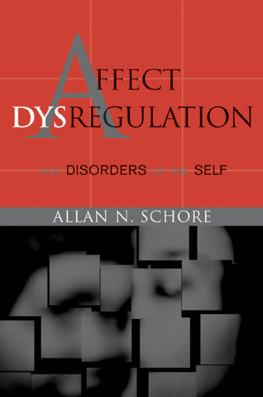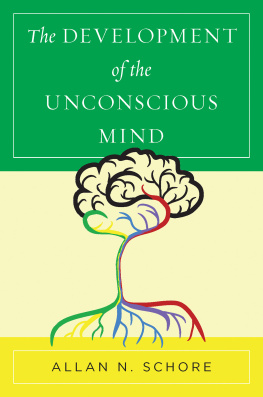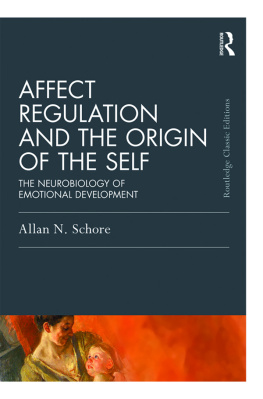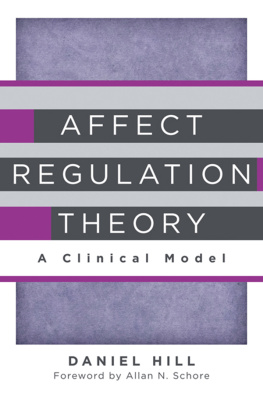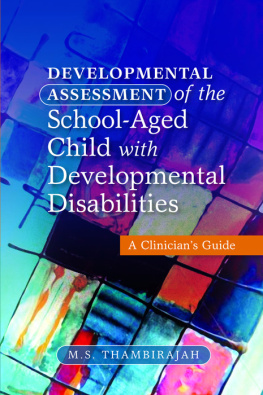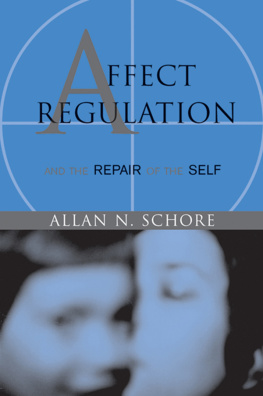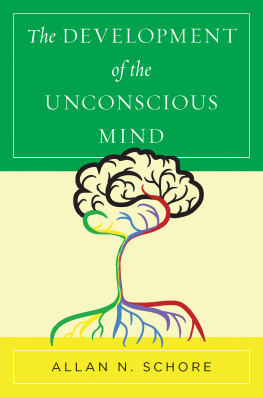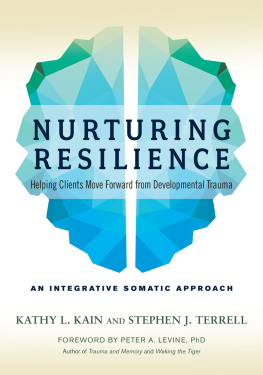
Affect Dysregulation
&
Disorders of the Self
ALLAN N. SCHORE

W.W. Norton & Company
New York London
Additional copyright information can be found in
Copyright 2003 by Allan N. Schore
All rights reserved
Printed in the United States of America
First Edition
For information about permission to reproduce
selections from this book, write to
Permissions, W. W. Norton & Company, Inc.,
500 Fifth Avenue, New York, NY 10110
Production Manager: Leeann Graham
Manufacturing by Haddon Craftsmen, Inc.
Library of Congress Cataloging-in-Publication Data
Schore, Allan N., 1943
Affect dysregulation and disorders of the self / Allan N. Schore.
p.cm.
A Norton professional book.
Includes bibliographical references and index.
Contents: v. 1 [no distinct title]v. 2 Affect regulation and repair of the self.
ISBN 0-393-70408-4 (set)ISBN 0-393-70406-8 (v. 1)ISBN 0-393-70407-6 (v. 2)
ISBN 978-0-393-73404-1 (e-book)
1. Affective disorders. 2. Self. 3. Self psychology. I. Title.
RC537.S3848 2003
616.85'27dc212002038055
W. W. Norton & Company, Inc., 500 Fifth Avenue, New York, N.Y. 10110
www.wwnorton.com
W. W. Norton & Company Ltd., Castle House, 75/76 Wells St., London W1T 3QT
We dance round in a ring and suppose,
But the Secret sits in the middle and knows.
Robert Frost, The Secret Sits
The Norton Series on Interpersonal Neurobiology
Daniel J. Siegel, M.D., Series Editor
The field of mental health is in a tremendously exciting period of growth and conceptual reorganization. Independent findings from a variety of scientific endeavors are converging in an interdisciplinary view of the mind and mental well-being. An interpersonal neurobiology of human development enables us to understand that the structure and function of the mind and brain are shaped by experiences, especially those involving emotional relationships.
The Norton Series on Interpersonal Neurobiology will provide cutting-edge, multidisciplinary views that further our understanding of the complex neurobiology of the human mind. By drawing on a wide range of traditionally-independent fields of researchsuch as neurobiology, genetics, memory, attachment, complex systems, anthropology, and evolutionary psychologythese texts will offer mental health professionals a review and synthesis of scientific findings often inaccessible to clinicians. These books aim to advance our understanding of human experience by finding the unity of knowledge, or consilience, that emerges with the translation of findings from numerous domains of study into a common language and conceptual framework. The series will integrate the best of modern science with the healing art of psychotherapy.
A NORTON PROFESSIONAL BOOK
To Judith
Wing to wing, oar to oar
Contents
I N 1994 I PUBLISHED Affect Regulation and the Origin of the Self, and in the very first paragraph I asserted, The beginnings of living systems set the stage for every aspect of an organisms internal and external functioning throughout the lifespan. In that book I outlined the principles of regulation theory. Using then-current information, I applied the theory to a model of how regulated and dysregulated affective transactions within the infants attachment relationship with the primary caregiver facilitate or inhibit the experience-dependent maturation of the infants brain, especially the early developing right brain. I then used the theory to generate a model of normal social-emotional development, of abnormal development and psychopathogeneis, and of the mechanism of developmental change, as expressed in the psychotherapeutic context.
Since 1994, and over the course of the Decade of the Brain, a vast amount of new information on these matters has appeared. Along the way I incorporated this data from a wide range of the biological, psychological, and social sciences into my research and publications. Due to the interdisciplinary nature of my work, these articles and chapters appear in journals and edited collections in a variety of fieldsdevelopmental psychopathology, psychiatry, neuroscience, psychoanalysis, as well as in the emotion, attachment, and trauma literatures.
This volume, Affect Dysregulation and Disorders of the Self and its companion, Affect Regulation and the Repair of the Self, are sequels to the first book, and represent expansions of my earlier presentation of regulation theory. Each contains a combination of already-published contributions as well as new material. Due to the fact that my writings are distributed over a wide array of disciplines, it has been difficult for a reader in one field to find publications in another. My intention is to provide readers with not only newer findings in a multitude of basic and clinical sciences, but also to offer an overarching perspective on regulation theory as it has expanded in the nine years since my first book. These two volumes thus represent the first comprehensive articulation of regulation theory as it has developed since Affect Regulation and the Origin of the Self.
In this volume, in Part 1 I present chapters in developmental affective neuroscience and then, in Part 2, developmental neuropsychiatry. Each chapter represents a further development of the original model. Because each development occurred at a particular point in time, and was guided by then-current research, the chapters in both parts are presented in chronological order. Some of the earlier chapters have been edited, and the more recent ones contain a good deal of new material that has not been previously published. The citations in each chapter reflect the incorporation of research that was available at the time of the original writing. The progression over the chapters reflects not only the tremendous expansion of relevant developmental and brain studies over the last decade, but also the dramatic emergence of data from neuroimaging technologies in this same time period. In essence, each chapter is a revision of the data and concepts of classical neurosciencei.e., from the lesion, neuroanatomical, and histological studies of brain preparations of classical nineteenth century neurology through the end of the twentieth centuryupon which Affect Regulation and the Origin of the Self was built.
The current explosion of research in the life sciences is commonly attributed to the remarkable advances in various technologies. Perhaps an even greater factor has been the significant increase in the amount of interdisciplinary research. In my earlier book I suggested that the frontiers of science are located in the borderland between the separate fields of science. Since 1994, this relationship between the biological and psychological realms has not only produced an enriched environment for multilevel research, but has also provided a powerful psychobiological perspective that has generated hypotheses for studies that assess human functions at various levels of analysis.
It is commonly accepted that this interdisciplinary approach is manifest in the construction of collaborative research teams that bring together scientists and clinicians from various fields of study. I suggest that progress in scientific knowledge also relies on interdisciplinary theoretical sciencethat is, the integration of the findings of interdisciplinary research data into testable and clinically relevant psychobiological models of human function and dysfunction. This synthesis of theoretical constructs and data is an intellectual enterprise. My own work in theoretical science is a contribution towards that effort. In this volume, along with the other two of the
Next page
